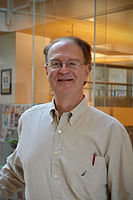
Photo from wikipedia
The electro-assisted autohydrogenotrophic reduction of perchlorate (ClO4-) was investigated in a dual-chamber biofilm-electrode reactor (BER), in which the microbial community was inoculated from natural sediments. To avoid the effect of… Click to show full abstract
The electro-assisted autohydrogenotrophic reduction of perchlorate (ClO4-) was investigated in a dual-chamber biofilm-electrode reactor (BER), in which the microbial community was inoculated from natural sediments. To avoid the effect of extreme pH and direct electron transfer on perchlorate reduction, a novel cathode configuration was designed. The pH of the cathode compartment was successfully controlled in the range of 7.2-8.4 during whole experiment. The effective biological autohydrogenotrophic reduction of perchlorate was achieved using hydrogen generated in-situ on the electrode surface, and the removal rate of 10 mg L-1 perchlorate reached 98.16% at HRT of 48 h. The highest perchlorate removal flux reached to 1498.420 mg m-2·d-1 with a 0.410 kW·h g-perchlorate-1 energy consumption. The microbial community evolution in the BER was determined by high-throughput sequencing and the results indicated that the Firmicutes and Bacteroidetes were dominant at phylum level when perchlorate concentration was 10 mg L-1 or lower. And the Proteobacteria became ascendant at the perchlorate concentration of 20 mg L-1. The functional populations for perchlorate reduction were successfully enriched including Nitrosomonas (30%), Thermomonas (9%), Comamonas (8%) and Hydrogenophaga (3%). Meanwhile, the proportion of functional population in biofilm linked to perchlorate concentration. With the increase of influent perchlorate concentration, the perchlorate-reducing bacteria (PRB) were enriched successfully and became ascendant.
Journal Title: Chemosphere
Year Published: 2020
Link to full text (if available)
Share on Social Media: Sign Up to like & get
recommendations!